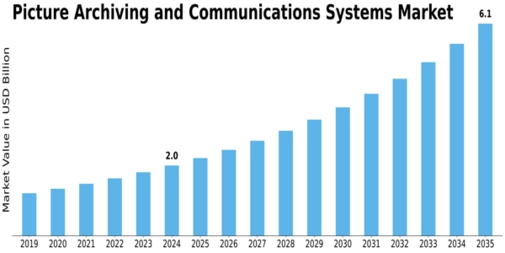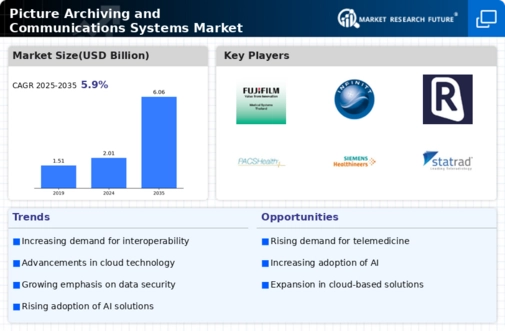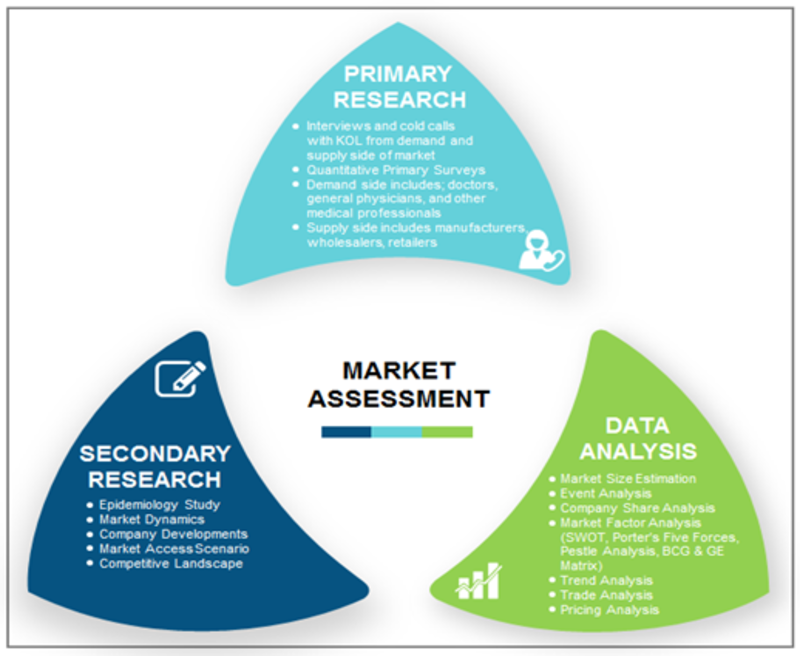-
Definition
-
Scope of the Study
- Research Objective
- Assumptions
- Limitations
-
Introduction
-
Primary Research
-
Secondary research
-
Market Size Estimation
-
Drivers
-
Restraints
-
Opportunities
-
Challenges
-
Macroeconomic Indicators
-
Technology Trends & Assessment
-
Porter’s Five Forces Analysis
- Bargaining Power of Suppliers
- Bargaining Power of Buyers
- Threat of New Entrants
- Threat of Substitutes
- Intensity of Rivalry
-
Value Chain Analysis
-
Investment Feasibility Analysis
-
Pricing Analysis
-
Chapter 6. Global Picture Archiving and Communications Systems (PACS) Market, by Type
-
Introduction
-
Oncology PACS
- Market Estimates & Forecast, 2020–2027
-
Cardiology PACS
- Market Estimates & Forecast, 2020–2027
-
Dental PACS
- Market Estimates & Forecast, 2020–2027
-
Orthopedics PACS
- Market Estimates & Forecast, 2020–2027
-
Others
- Market Estimates & Forecast, 2020–2027
-
Chapter 7. Global Picture Archiving and Communications Systems (PACS) Market, by Component
-
Introduction
-
Hardware
- Market Estimates & Forecast, 2020–2027
-
Software
- Market Estimates & Forecast, 2020–2027
-
Services
- Market Estimates & Forecast, 2020–2027
-
Chapter 8. Global Picture Archiving and Communications Systems (PACS) Market, by Imaging Type
-
Introduction
-
Magnetic Resonance Imaging (MRI)
- Market Estimates & Forecast, 2020–2027
-
Computed Tomography (CT)
- Market Estimates & Forecast, 2020–2027
-
Nuclear Imaging
- Market Estimates & Forecast, 2020–2027
-
X-ray
- Market Estimates & Forecast, 2020–2027
-
Ultrasound
- Market Estimates & Forecast, 2020–2027
-
Chapter 9. Global Picture Archiving and Communications Systems (PACS) Market, by Delivery Mode
-
Introduction
-
Cloud-Based (SAAS) Delivery Mode
- Market Estimates & Forecast, 2020–2027
-
Web Hosted (On-Demand) Delivery Mode
- Market Estimates & Forecast, 2020–2027
-
On-Premise Mode
- Market Estimates & Forecast, 2020–2027
-
Chapter 10. Global Picture Archiving and Communications Systems (PACS) Market, by End-User
-
Introduction
-
Hospitals & Clinics
- Market Estimates & Forecast, 2020–2027
-
Health Care Centers
- Market Estimates & Forecast, 2020–2027
-
Imaging Centers
- Market Estimates & Forecast, 2020–2027
-
Diagnostic Centers
- Market Estimates & Forecast, 2020–2027
-
Clinical Research Institutions
- Market Estimates & Forecast, 2020–2027
-
Others
- Market Estimates & Forecast, 2020–2027
-
Chapter 11. Global Picture Archiving and Communications Systems (PACS) Market, by Region
-
Introduction
-
Americas
- North America
- South America
-
Europe
- Western Europe
- Eastern Europe
-
Asia Pacific
- Japan
- China
- India
- Australia
- Republic of Korea
- Rest of Asia Pacific
-
The Middle East & Africa
- United Arab Emirates
- Saudi Arabia
- Oman
- Kuwait
- Qatar
- Rest of the Middle East & Africa
-
Chapter 12 Company Landscape
-
Introduction
-
Market Share Analysis
-
Key Development & Strategies
- Key Developments
-
Chapter 13 Company Profiles
-
Advanced Data Systems
- Company Overview
- Types Overview
- Financials
- SWOT Analysis
-
Agfa-Gevaert N.V.
- Company Overview
- Types Overview
- Financial Overview
- Key Developments
- SWOT Analysis
-
McKesson Corporation
- Company Overview
- Types Overview
- Financial Overview
- Key Development
- SWOT Analysis
-
Avreo, Inc.
- Company Overview
- Types/Business Segment Overview
- Financial Overview
- Key Development
- SWOT Analysis
-
SIEMENS HEALTHINEERS
- Company Overview
- Types Overview
- Financial overview
- Key Developments
-
Singular Medical Technologies
- Company Overview
- Types Overview
- Financial Overview
- Key Developments
-
GE Healthcare
- Overview
- Types Overview
- Financials
- Key Developments
- SWOT Analysis
-
Others
-
Chapter 14 MRFR Conclusion
-
Key Findings
- From CEO’s View Point
- Unmet Needs of the Market
-
Key Companies to Watch
-
Prediction of the Picture Archiving and Communications Systems (PACS) Industry
-
Chapter 15 Appendix
-
LIST OF TABLES
-
Picture Archiving and Communications Systems (PACS) Industry Synopsis, 2020–2027
-
Picture Archiving and Communications Systems (PACS) Market Estimates & Forecast, 2020–2027, (USD Million)
-
Picture Archiving and Communications Systems (PACS) Market, by Region, 2020–2027, (USD Million)
-
Picture Archiving and Communications Systems (PACS) Market, by Type, 2020–2027, (USD Million)
-
Picture Archiving and Communications Systems (PACS) Market, by Component, 2020–2027, (USD Million)
-
Picture Archiving and Communications Systems (PACS) Market, by Imaging Type, 2020–2027, (USD Million)
-
Picture Archiving and Communications Systems (PACS) Market, by Delivery Mode, 2020–2027, (USD Million)
-
Picture Archiving and Communications Systems (PACS) Market, by End-User, 2020–2027, (USD Million)
-
North America Picture Archiving and Communications Systems (PACS) Market, by Type, 2020–2027, (USD Million)
-
North America Picture Archiving and Communications Systems (PACS) Market, by Component, 2020–2027, (USD Million)
-
North America Picture Archiving and Communications Systems (PACS) Market, by Imaging Type, 2020–2027, (USD Million)
-
North America Picture Archiving and Communications Systems (PACS) Market, by Delivery Mode, 2020–2027, (USD Million)
-
North America Picture Archiving and Communications Systems (PACS) Market, by End-User, 2020–2027, (USD Million)
-
U.S. Picture Archiving and Communications Systems (PACS) Market, by Type, 2020–2027, (USD Million)
-
U.S. Picture Archiving and Communications Systems (PACS) Market, by Component, 2020–2027, (USD Million)
-
U.S. Picture Archiving and Communications Systems (PACS) Market, by Imaging Type, 2020–2027, (USD Million)
-
U.S. Picture Archiving and Communications Systems (PACS) Market, by Delivery Mode, 2020–2027, (USD Million)
-
U.S. Picture Archiving and Communications Systems (PACS) Market, by End-User, 2020–2027, (USD Million)
-
Canada Picture Archiving and Communications Systems (PACS) Market, by Type, 2020–2027, (USD Million)
-
Canada Picture Archiving and Communications Systems (PACS) Market, by Component, 2020–2027, (USD Million)
-
Canada Picture Archiving and Communications Systems (PACS) Market, by Imaging Type, 2020–2027, (USD Million)
-
Canada Picture Archiving and Communications Systems (PACS) Market, by Delivery Mode, 2020–2027, (USD Million)
-
Canada Picture Archiving and Communications Systems (PACS) Market, by End-User, 2020–2027, (USD Million)
-
South America Picture Archiving and Communications Systems (PACS) Market, by Type, 2020–2027, (USD Million)
-
South America Picture Archiving and Communications Systems (PACS) Market, by Component, 2020–2027, (USD Million)
-
South America Picture Archiving and Communications Systems (PACS) Market, by Imaging Type, 2020–2027, (USD Million)
-
South America Picture Archiving and Communications Systems (PACS) Market, by Delivery Mode, 2020–2027, (USD Million)
-
South America Picture Archiving and Communications Systems (PACS) Market, by End-User, 2020–2027, (USD Million)
-
Europe Picture Archiving and Communications Systems (PACS) Market, by Type, 2020–2027, (USD Million)
-
Europe Picture Archiving and Communications Systems (PACS) Market, by Component, 2020–2027, (USD Million)
-
Europe Picture Archiving and Communications Systems (PACS) Market, by Imaging Type, 2020–2027, (USD Million)
-
Europe Picture Archiving and Communications Systems (PACS) Market, by Delivery Mode, 2020–2027, (USD Million)
-
Europe Picture Archiving and Communications Systems (PACS) Market, by End-User, 2020–2027, (USD Million)
-
Western Europe Picture Archiving and Communications Systems (PACS) Market, by Type, 2020–2027, (USD Million)
-
Western Europe Picture Archiving and Communications Systems (PACS) Market, by Component, 2020–2027, (USD Million)
-
Western Europe Picture Archiving and Communications Systems (PACS) Market, by Imaging Type, 2020–2027, (USD Million)
-
Western Europe Picture Archiving and Communications Systems (PACS) Market, by Delivery Mode, 2020–2027, (USD Million)
-
Western Europe Picture Archiving and Communications Systems (PACS) Market, by End-User, 2020–2027, (USD Million)
-
Eastern Europe Picture Archiving and Communications Systems (PACS) Market, by Type, 2020–2027, (USD Million)
-
Eastern Europe Picture Archiving and Communications Systems (PACS) Market, by Component, 2020–2027, (USD Million)
-
Eastern Europe Picture Archiving and Communications Systems (PACS) Market, by Imaging Type, 2020–2027, (USD Million)
-
Eastern Europe Picture Archiving and Communications Systems (PACS) Market, by Delivery Mode, 2020–2027, (USD Million)
-
Eastern Europe Picture Archiving and Communications Systems (PACS) Market, by End-User, 2020–2027, (USD Million)
-
Asia Pacific Picture Archiving and Communications Systems (PACS) Market, by Type, 2020–2027, (USD Million)
-
Asia Pacific Picture Archiving and Communications Systems (PACS) Market, by Component, 2020–2027, (USD Million)
-
Asia Pacific Picture Archiving and Communications Systems (PACS) Market, by Imaging Type, 2020–2027, (USD Million)
-
Asia Pacific Picture Archiving and Communications Systems (PACS) Market, by Delivery Mode, 2020–2027, (USD Million)
-
Asia Pacific Picture Archiving and Communications Systems (PACS) Market, by End-User, 2020–2027, (USD Million)
-
The Middle East & Africa Picture Archiving and Communications Systems (PACS) Market, by Type, 2020–2027, (USD Million)
-
The Middle East & Africa Picture Archiving and Communications Systems (PACS) Market, by Component, 2020–2027, (USD Million)
-
The Middle East & Africa Picture Archiving and Communications Systems (PACS) Market, by Imaging Type, 2020–2027, (USD Million)
-
The Middle East & Africa Picture Archiving and Communications Systems (PACS) Market, by Delivery Mode, 2020–2027, (USD Million)
-
The Middle East & Africa Picture Archiving and Communications Systems (PACS) Market, by End-User, 2020–2027, (USD Million)
-
LIST OF FIGURES
-
Research Process
-
Segmentation for Picture Archiving and Communications Systems (PACS) Market
-
Segmentation Market Dynamics for Picture Archiving and Communications Systems (PACS) Market
-
Global Picture Archiving and Communications Systems (PACS) Market Share, by Type 2020
-
Global Picture Archiving and Communications Systems (PACS) Market Share, by Component 2020
-
Global Picture Archiving and Communications Systems (PACS) Market Share, by Imaging Type 2020
-
Global Picture Archiving and Communications Systems (PACS) Market Share, by Delivery Mode 2020
-
Global Picture Archiving and Communications Systems (PACS) Market Share, by End-User 2020
-
North America Picture Archiving and Communications Systems (PACS) Market Share, by Country, 2020
-
Europe Picture Archiving and Communications Systems (PACS) Market Share, by Country, 2020
-
Asia Pacific Picture Archiving and Communications Systems (PACS) Market Share, by Country, 2020
-
Middle East & Africa Picture Archiving and Communications Systems (PACS) Market Share, by Country, 2020
-
Global Picture Archiving and Communications Systems (PACS) Market: Company Share Analysis, 2020 (%)
-
Advanced Data Systems: Key Financials
-
Advanced Data Systems: Segmental Revenue
-
Advanced Data Systems: Geographical Revenue
-
Agfa-Gevaert N.V.: Key Financials
-
Agfa-Gevaert N.V.: Segmental Revenue
-
Agfa-Gevaert N.V.: Geographical Revenue
-
McKesson Corporation: Key Financials
-
McKesson Corporation: Segmental Revenue
-
McKesson Corporation: Geographical Revenue
-
Avreo, Inc.: Key Financials
-
Avreo, Inc.: Segmental Revenue
-
Avreo, Inc.: Geographical Revenue
-
SIEMENS HEALTHINEERS: Key Financials
-
SIEMENS HEALTHINEERS: Segmental Revenue
-
SIEMENS HEALTHINEERS Geographical Revenue
-
Singular Medical Technologies: Key Financials
-
Singular Medical Technologies: Segmental Revenue
-
Singular Medical Technologies: Geographical Revenue
-
GE HEALTHCARE: Key Financials
-
GE HEALTHCARE: Segmental Revenue
-
GE HEALTHCARE: Geographical Revenue
-
"









 Sources: Annual reports, Press release, White paper, and Company presentations
Sources: Annual reports, Press release, White paper, and Company presentations








Leave a Comment